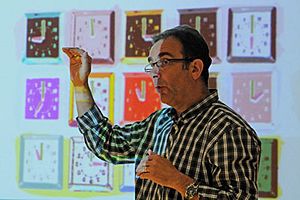Michael Harvey Hastings facts for kids
Quick facts for kids
Michael Harvey Hastings
FMedSci FRS
|
|
|---|---|
 |
|
| Nationality | British |
| Alma mater |
|
| Scientific career | |
| Fields |
|
| Institutions |
|
| Thesis | Aspects of the ecology of sandy shore crustacea |
| Doctoral advisor | Ernest Naylor |
Michael Harvey Hastings is a British scientist who studies how living things keep track of time. He works at the Medical Research Council MRC Laboratory of Molecular Biology (LMB) in Cambridge, UK. He is well-known for helping us understand "biological clocks" in both tiny sea creatures and mammals, like humans. These clocks control things like when we sleep and wake up.
Contents
Early Life and Education
Michael Hastings went to the University of Liverpool to study marine biology, which is the study of sea life. This was in 1974. He then did his PhD research at the University’s Port Erin Marine Biological Station on the Isle of Man. His studies there focused on how sea creatures tell time.
After his PhD, he thought about becoming a science teacher. He earned a teaching certificate from the Victoria University of Manchester. However, he decided to continue his work in biological research instead. He is married to another neuroscientist, Angela Charlotte Roberts.
Discovering Biological Clocks
Dr. Hastings' PhD work introduced him to the idea of "biological clocks." These are natural systems in living things that control when certain activities happen. For example, they control daily sleep-wake cycles or even how some sea creatures respond to the tides. He studied a small marine creature called Eurydice pulchra to understand its daily and monthly rhythms.
How Mammals Keep Time
Later, Dr. Hastings moved to Cambridge to study how mammals keep track of time, especially for seasonal changes. He focused on the pineal gland and a hormone it produces called melatonin. Melatonin helps control things like reproduction and metabolism based on how much light there is each day.
In 1984, he became a lecturer and continued his research. He studied how melatonin affects the brain. He also looked at the brain's main "body clock," which is called the suprachiasmatic nucleus (SCN). The SCN is a tiny part of the hypothalamus, a control center in the brain.
Modern Research on Body Clocks
In 2001, Dr. Hastings joined the MRC Laboratory of Molecular Biology. Here, he started using advanced genetic methods to understand the SCN's inner workings. His recent work has focused on:
- The genetic basis of how cells keep time in mammals.
- How cells in the SCN talk to each other to keep the body clock working smoothly.
- How these body clock mechanisms affect normal metabolism.
- What happens when these clocks go wrong in brain diseases.
Since 2015, Dr. Hastings has been the sole Head of the Neurobiology Division at the MRC Laboratory of Molecular Biology.
Awards and Recognition
Dr. Hastings has received many awards for his important work on biological clocks:
- 1996 - Mortyn Jones Prize, British Society for Neuroendocrinology
- 2007 - “Aschoff’s Rule” award, Gordon Conference on Chronobiology
- 2008 - Elected as a Fellow of the Academy of Medical Sciences
- 2008 - Elected as President of the Society for Research on Biological Rhythms
- 2010 - Elected as a Fellow of the Royal Society
- 2013 - Special Award Lecturer, British Society for Neuroendocrinology
- 2014 - Ellison-Cliffe Lecture Prize and Medal, Royal Society of Medicine
- 2018 - Brenner Lecturer, The Salk Institute
- 2018 - MRC Plenary Lecturer at the Society for Toxicology

